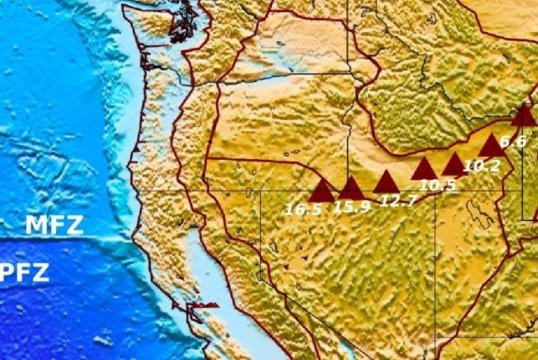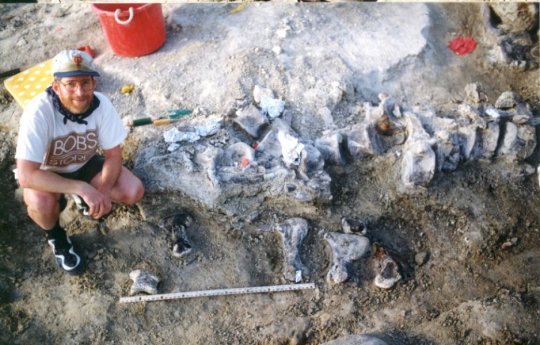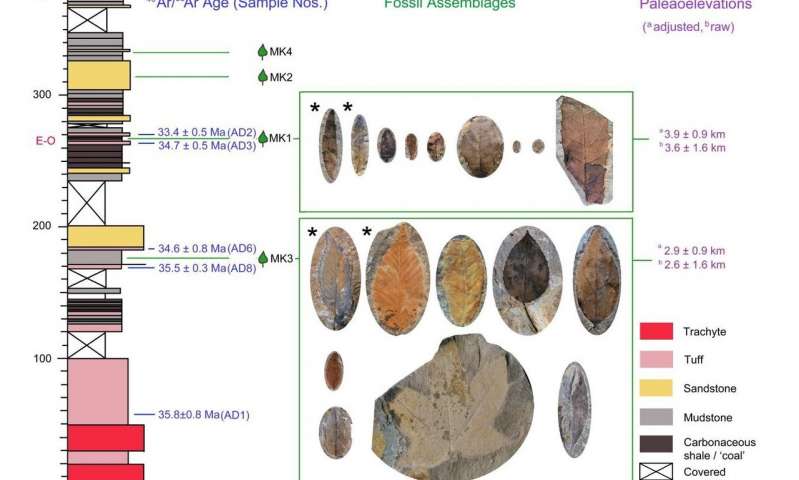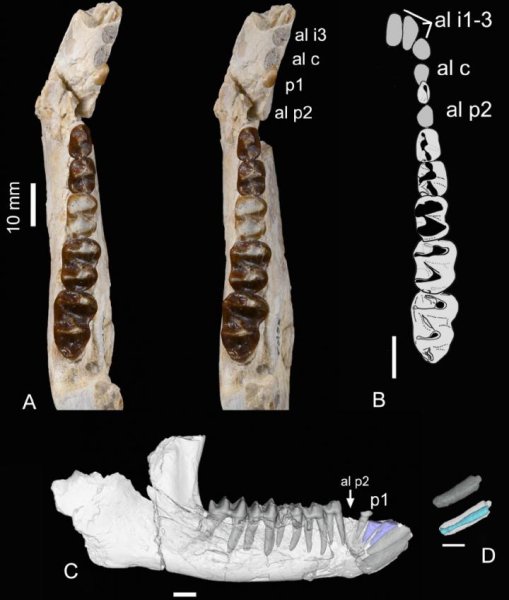Akainacephalus was announced today in the open-access scientific journal PeerJ and unveiled on exhibit in the Past Worlds Gallery of the Natural History Museum of Utah at the Rio Tinto Center in Salt Lake City, Utah. The genus name is derived from the Greek words akaina, which means ‘thorn’ or ‘spike’, and cephalus, meaning ‘head.’ The species epithet johnsoni honors Randy Johnson, a dedicated museum volunteer who skillfully prepared its skull. Other talented volunteers helped to prepare the rest of the specimen.
“I’m a retired chemist, but I’ve always been interested in most of the science disciplines. I never thought that I would have the opportunity to actually work on fossils that could be important for paleontologists,” said Randy Johnson. “Now that I’m a museum volunteer, I’m getting the opportunity to work on a large variety of fossils and consult with top paleontologists — it’s like a dream second career. I couldn’t believe it when they told me they are naming the ankylosaur after me, a once in a lifetime honor,” said Johnson.
Ankylosaurids are a group of four-legged herbivorous armored dinosaurs with imposing bony tail clubs. Though ankylosaurids originated in Asia between 125 — 100 million years ago, they do not appear in the western North American fossil record until ~77 million years ago. The new species Akainacephalus lived 76 million years ago during the Late Cretaceous Period and offers the most complete skeleton of an ankylosaurid dinosaur found in the southwestern US. It includes a complete skull, much of the vertebral column, including a complete tail club, several fore and hind limbs elements, and bony body armor that includes two neck rings and spiked armor plates.
The unique arrangement of bony armor in the shape of small cones and pyramids covering the snout and head is the key research finding indicating that Akainacephalus is closely related to the New Mexican ankylosaurid Nodocephalosaurus kirtlandensis. Surprisingly, Akainacephalus and Nodocephalosaurus are more closely related to Asian ankylosaurids such as Saichania and Tarchia than to other Late Cretaceous North American ankylosaurids, including Ankylosaurusand Euoplocephalus. Both of the latter taxa possess flat skull armor.
“A reasonable hypothesis would be that ankylosaurids from Utah are related to those found elsewhere in western North America, so we were really surprised to discover that Akainacephalus was so closely related to species from Asia,” remarked Randall Irmis, co-author of the study.
Though ankylosaurids originated in Asia between 125 — 100 million years ago, they do not appear in the North American fossil record until around 77 million years ago. Akainacephalus once roamed the southern part of Laramidia, a landmass on the western coast of a shallow sea that flooded the central region, splitting the continent of North America in two. This caused isolation along western and eastern portions of the North American continent during the Late Cretaceous Period, between 95-70 million years ago.
Lead author Jelle Wiersma suggests that the geographic distribution of Late Cretaceous ankylosaurids throughout the Western Interior was the result of several geologically brief intervals of lowered sea level that allowed Asian ankylosaurid dinosaurs to immigrate to North America several times during the Late Cretaceous, resulting in the presence of two separate groups of ankylosaurid dinosaurs. This lowering of sea levels exposed the Beringian land bridge, allowing dinosaurs and other animals to move between Asia and North America.
“It is always exciting to name a new fossil taxon, but it is equally exciting if that taxon also provides additional insights into the bigger picture of its life, such as its diet or aspects of its behavior, and the environment it lived in,” said Wiersma. “Such is exactly the case with Akainacephalus johnsoni; not only is this the first described and named Late Cretaceous ankylosaurid dinosaur from Utah, but this unique animal also strengthens the evidence that distinct northern and southern provincialism existed during the late Campanian stage in Laramidia, because to date, we don’t see this type of ankylosaurid dinosaurs in the fossil record of northern Laramidia,” he said.
Wiersma explained that additionally, together with its close relative Nodocephalosaurus from New Mexico, Akainacephalus looks very different compared to other North American ankylosaurids such as Ankylosaurus, but instead, look much more like Asian ankylosaurids including Saichania and Tarchia. From these observations we can conclude that at least two immigration events took place during Late Cretaceous times when lowered sea levels exposed the Beringian land bridge, connecting Asia with western North America.
Ankylosaurid dinosaurs, among many other groups of animals, eventually crossed this land bridge, emigrating from Asia into western North America, resulting into two different types of Late Cretaceous ankylosaurid dinosaurs: ones that evolved flatter skull armor like Ankylosaurus and Euoplocephalus, and ones possessing very spiky skull armor such as Akainacephalus and Nodocephalosaurus.
“It is extremely fascinating and important for the science of paleontology that we can read so much information from the fossil record, allowing us to better understand extinct organisms and the ecosystems they were a part of,” concluded Wiersma.
These new findings are part of a study funded in large part by the Bureau of Land Management, as well as the Geological Society of America, and a University of Utah Department of Geology & Geophysics Graduate Student Grant. The project was led by University of Utah M.Sc. student Jelle Wiersma, now a Ph.D. student in the Dept. of Geosciences at James Cook University, Queensland, Australia. Wiersma was advised by co-author Dr. Randall Irmis, chief curator and curator of paleontology at the Natural History Museum of Utah, and associate professor in the Dept. of Geology and Geophysics, University of Utah.
Anklysaurid Dinosaurs on the Lost Continent of Southern Laramidia
Akainacephalus johnsoni was discovered in Grand Staircase-Escalante National Monument (GSENM) which encompasses a large area of high desert terrain in south-central Utah. This vast and rugged region, part of the National Landscape Conservation System administered by the Bureau of Land Management (BLM), was the last major area in the lower 48 states to be formally mapped by cartographers.
During the Late Cretaceous, GSENM was in the southern portion of Laramidia, which stretched from the Arctic Circle to the Gulf of Mexico. Akainacephalus is part of a growing number of new dinosaur discoveries over the past 15 years demonstrating the incredible diversity of animals and plants living on Laramidia between 80-75 million years ago. One of the most exciting conclusions from this work is that nearly every species of dinosaur discovered in GSENM is new to science, and Akainacephalus is no exception. Other recently discovered species include large and small meat-eating dinosaurs (e.g., tyrannosaurs), horned dinosaurs, and duck-billed dinosaurs. “A major long-term goal of our work in southern Utah is to try and understand why the species in GSENM differ from relatives of the same geologic age found in other parts of Laramidia,” said Wiersma. Hypotheses for the differences include changes in sea level, climate differences across latitude, and physical barriers to animal movement such as mountains and large rivers.
Fact Sheet: Major Points of the Paper
(1) Akainacephalus is a remarkable new species of ankylosaurid dinosaur from the upper Campanian Kaiparowits Formation in Grand Staircase-Escalante National Monument in Kane County, southern Utah.
(2) Akainacephalus is the most complete Late Cretaceous ankylosaurid dinosaur discovered from Utah and the southwestern U.S., and is distinguished by a number of unique features, including spikes and cones of the bony exterior covering the head and snout.
(3) The spikes and cones of bony armor on the skull of Akainacephalus are similar to those found on the New Mexican ankylosaurid Nodocephelausaurus kirtlandensis but distinct from all other known Late Cretaceous Laramidian ankylosaurids such as Ankylosaurus, Euoplocephalus, and Ziapelta, indicating these two species are more closely related to some Asian ankylosaurids.
(4) The new ankylosaurid Akainacephalus suggests multiple ankylosaurid emigration events from Asia to Laramidia during the Late Cretaceous.
(5) Together with some anklylosaurid dinosaurs from northern Laramidia, including Dyoplosaurus acutossquameus and Scolosaurus cutleri (both ~ 77 Ma), Akainacephalus represents one of the oldest known ankylosaurid dinosaurs from the Late Cretaceous of western North America (~76 Ma).
New Dinosaur Name: Akainacephalus johnsoni
- The first part of the name, Akaina, is a Greek word that can be translated to spike or thorn. The second part of the name cephalus means head, and the epithet johnsoni honors Randy Johnson, a dedicated paleontology volunteer at the Natural History Museum of Utah who prepared the specimen’s skull.
Size
- Akainacephalus, is a medium-sized dinosaur, and was 13-16 feet long (4-5 meters) and was 3 ½ feet tall (1 — 1.5 meters) at the hips.
Relationships
- Akainacephalus belongs to a group of herbivorous armored dinosaurs called anklosaurids that lived in Asia and western North America during the Late Cretaceous Period (100-66 million years ago). One of the unique features of ankylosaurid dinosaurs is the presence of a characteristic bony tail club.
Anatomy
- Akainacephalus walked on four legs, which were positioned directly underneath his body.
- Akainacephalus was covered in bony armor from head to tail, with various sized and shaped bony plates, called osteoderms, which are thought to provide protection.
- Akainacephalus is characterized by its elaborate covering of spikes and horns on the skull, as well a large bony club at the end of its tail.
- Akainacephalus presumably had small, leaf-shaped teeth for eating plants. These fell out of the jaw after death, but before the skeleton was buried by sediment.
Age and Geography
- Akainacephalus lived during the upper Campanian stage of the Late Cretaceous Period, which spanned from approximately 84 million to 72 million years ago. This animal lived about 76 million years ago.
- Akainacephalus was discovered in 76 Ma old rocks of the Kaiparowits Formation, a geological/stratigraphic unit exposed in southern Utah consisting of sedimentary rocks deposited by rivers and streams.
Discovery & Excavation
- Akainacephalus was first discovered in 2008 during a museum-led paleontological expedition in a remote area of BLM-administered Grand Staircase-Escalante National Monument (GSENM) in Kane County, southern Utah, USA. The site was discovered by BLM employee Scott Richardson.
- The bones of Akainacephalus that were discovered include a complete skull, bony armor that includes neck rings and spiked plates, many vertebrae, forelimb and hindlimb bones, and a near complete tail with tail club.
- Akainacephalus was found together with skeletons of several other animals at the same site, including a duck-bill dinosaur (Gryposaurus), a recently-described species of turtle (Arvinachelys), and a yet unnamed relative of alligators and caimans).
- Akainacephalus is permanently housed in the collections of the Natural History Museum of Utah at the Rio Tinto Center in Salt Lake City and on public display at the museum’s Past Worlds exhibit.
- These discoveries are the result of an ongoing collaboration between the Natural History Museum of Utah and the Bureau of Land Management.
Preparation
- It required almost four years to fully prepare all of the bones of Akainacephalus.
- Preparation of the skull was done by museum volunteer Randy Johnson, who is honored in the new name, Akainacephalus johnsoni
Credits: Sciencedaily.com













 July 30th, 2018
July 30th, 2018  Riffin
Riffin 




![Hypothesis of evolutionary relationships of Torrejonia wilsoni and other eutherian mammals. (Left) Resulting single most parsimonious cladogram based on modified morphological dataset of Bloch et al. [4], sampling a total of 240 morphological characters (68 postcranial, 45 cranial and 127 dental) with Primates sensu lato indicated in blue and Torrejonia wilsoni supported as a stem primate and indicated in orange. Numbers below branches represent Absolute Bremer Support values. See the electronic supplementary material for detailed methods, descriptions of morphological characters, specimens examined (also see [5]), and the taxon-character matrix in TNT format. (Bottom) Simplified subset of resulting tree topology focused on Primates. Boxes (a–f) illustrate tarsals of select primates with great mobility at the upper ankle joint (yellow: lateral tibial facet extends distally onto neck of astragalus in dorsal view), lower ankle joint (red: sustentacular facet extends distally onto body of calcaneus in dorsal view) and transverse tarsal joint (orange: round, concave cuboid facet of calcaneus in distal view) indicating arboreality. Boxes (a–f) also illustrate micro X-ray CT scan reconstructions of (a) purgatoriid Purgatorius unio p4-m3 (UCMP 107406) with tall molar cusps in buccal view, (b) micromomyid Dryomomys szalayi cranium (UM 41870) in right lateral view with large IOF, (c) Torrejonia wilsoni partial skeleton (NMMNH P-54500), (d) paromomyid Ignacius graybullianus cranium (USNM 421608) in right lateral view with relatively large olfactory bulbs (OB) of endocast (violet), (e) carpolestid Carpolestes simpsoni cranium (USNM 482354) in right lateral view and tarsals (UM 101963) and (f) notharctid Notharctus tenebrosus cranium (AMNH 127167) in right lateral view. Some elements reversed for clarity. See figure 3 legend for specimen numbers of tarsals not listed above. See the electronic supplementary material for institutional abbreviations.](http://www.worldfossilsociety.org/wp-content/uploads/2018/07/180206100338_1_900x600.gif)

